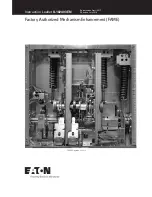
27
High-speed moving parts.
Can result in serious injury.
Tripping spring is charged. If trip latch is moved, the stored-energy springs
will discharge rapidly.
Stay clear of circuit breaker components that are subject to sudden, high-
speed movement.
Manual spring-charging and contact-
erosion checks
Perform the manual spring-charging check
contained in the section describing the
installation check and initial functional tests
(refer to pages 6-7). The key steps of this
procedure are repeated here:
1. Insert the hand-charging crank into the
manual-charge socket at the front of the
operator control panel. Turn the crank
clockwise (about 48 revolutions) to
charge the closing spring. Continue
cranking until the CHARGED flag appears
in the window of the spring indicator.
2. Press the Close (black) pushbutton. The
contact-position indicator on the operator
control-panel should indicate that the
circuit breaker contacts are closed.
3. Perform the contact-erosion check.
Contact erosion occurs when high fault-
currents are interrupted. Determination of
acceptable contact condition is checked
by the visibility of the white contact-
erosion mark shown in Figure 17:
Contact-erosion check mark dot (circled in
orange) (shown with circuit breaker
OPEN). The white contact-erosion mark is
located on the movable stem of the
vacuum interrupter, near the plastic
guide-bushing. The contact-erosion check
procedure is:
a) Be sure the circuit breaker primary
contacts are closed.
b) Observe the white contact-erosion
mark (refer to Figure 17) of each pole.
When any part of the white contact-
erosion mark is visible, contact wear is
within acceptable limits. A mechanic’s
mirror is a convenient means for
viewing the contact-erosion mark on
each vacuum interrupter.
4. Press the red open pushbutton after
completing the contact-erosion check.
Visually verify the discharged condition of
the closing spring and that the circuit
breaker contacts are open.
5. Press the black close pushbutton. Nothing
should happen. The manual-spring check
should demonstrate smooth operation of
the operating mechanism.
Electrical control checks
The electrical controls of the circuit breaker
should be checked during inspections to
verify absence of any mechanical damage,
and proper operation of the automatic spring-
charging and close and trip circuits.
Unless otherwise noted, all of these tests are
performed without any control power applied
to the circuit breaker.
Check of the wiring and terminals
1. Physically check all of the circuit breaker
wiring for evidence of abrasion, cuts,
burning or mechanical damage.
2. Check all terminals to be certain they are
solidly attached to their respective device.
Figure 17: Contact-erosion check
mark dot (circled in orange) (shown
with circuit breaker OPEN)
Summary of Contents for 3AH35-SE Series
Page 46: ...46 Table 13 Remarks ...
Page 47: ...47 Table 13 Remarks continued ...
















































